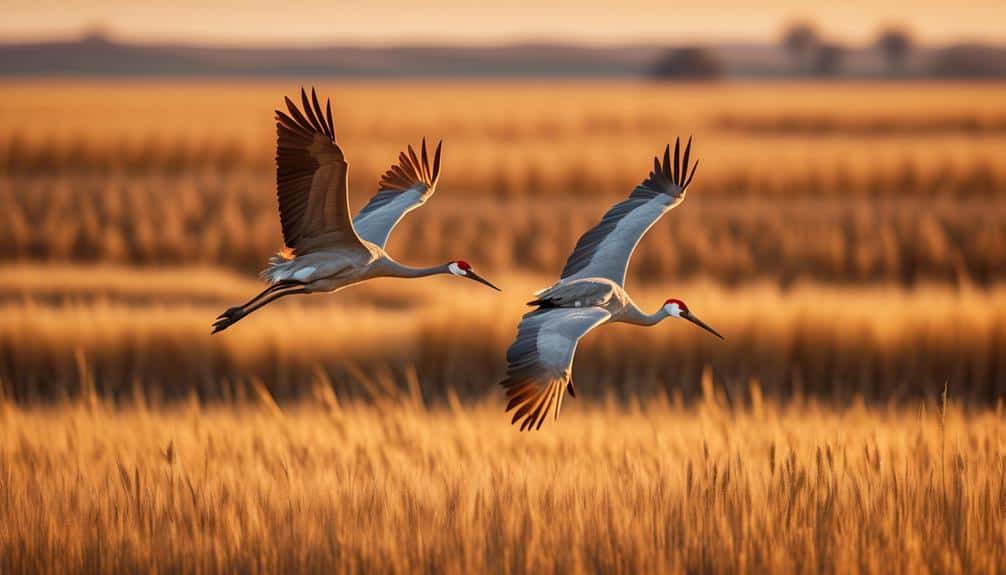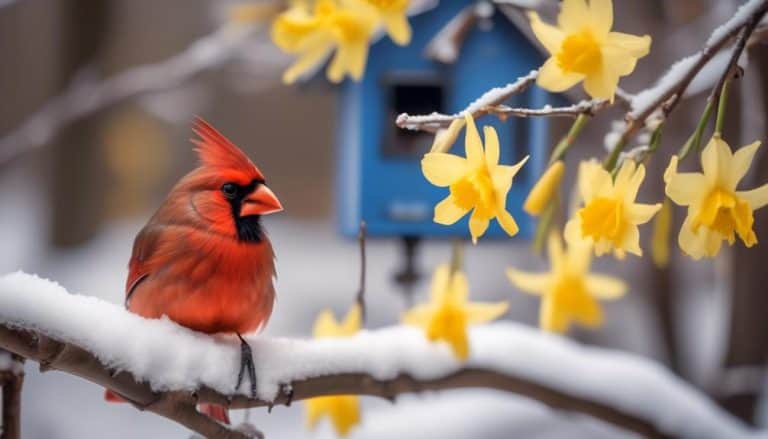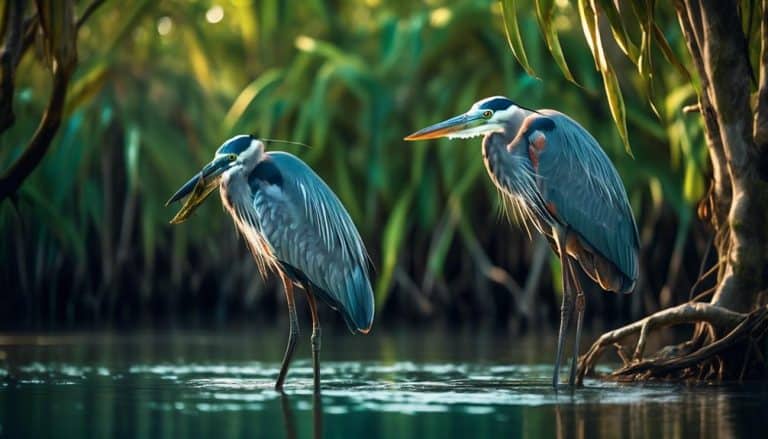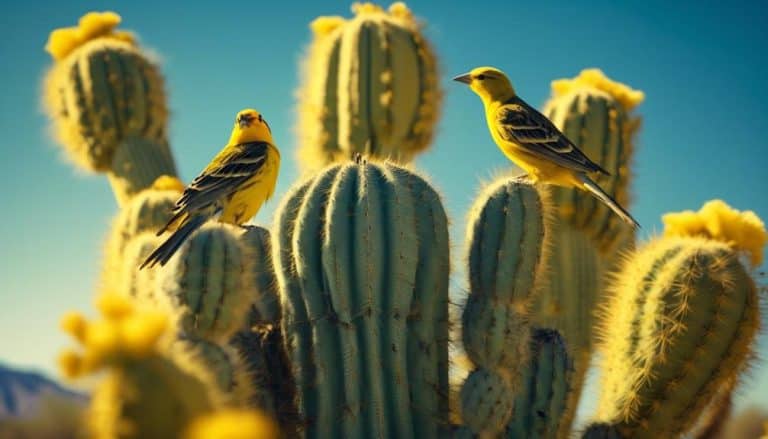They say that birds of a feather flock together, and in the vast open spaces of Nebraska, that adage holds true.
From the graceful flight of the Red-tailed Hawk to the melodic tunes of the American Goldfinch, the state is home to a diverse array of common birds.
But what makes these feathered creatures so fascinating? Well, let me tell you, there's more to it than meets the eye.
So, buckle up and get ready to embark on a journey through the skies of Nebraska, where the wonders of avian life await.
The American Goldfinch
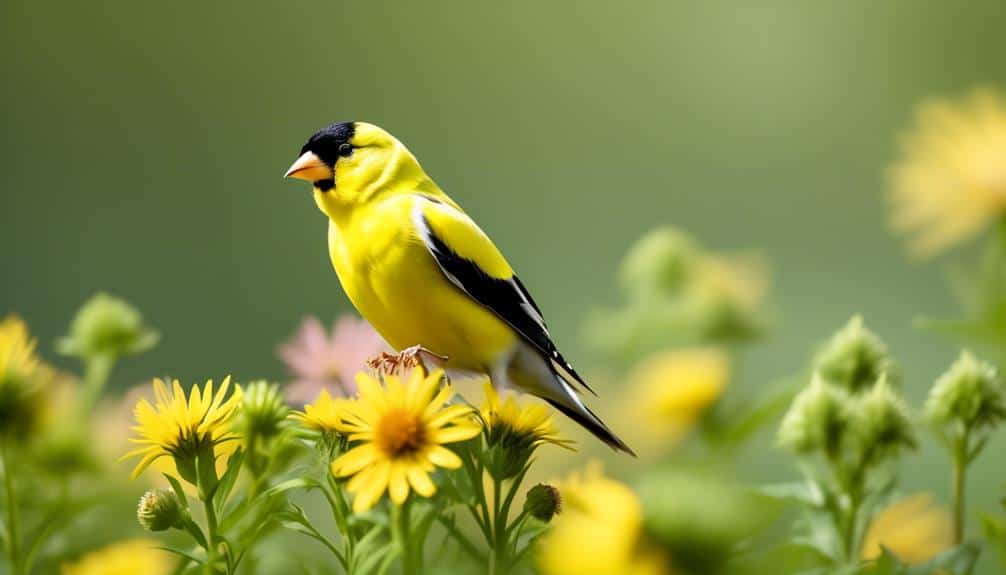
The American Goldfinch, also known as Spinus tristis, is a small songbird that's commonly found throughout the state of Nebraska. This species is known for its vibrant yellow plumage and distinctive song. In terms of breeding habits, American Goldfinches are late nesters, typically beginning their breeding season in June or July. Unlike many other bird species, they prefer to nest in open woodlands and shrubby areas rather than dense forests. The female builds a cup-shaped nest using plant fibers, grasses, and spider silk, often weaving it into the branches of a shrub or tree.
When it comes to diet preferences, the American Goldfinch primarily feeds on seeds. They've a particular fondness for the seeds of thistles, sunflowers, and dandelions. Their specialized bill allows them to extract seeds from the plants with ease. During the breeding season, they also incorporate insects into their diet to provide essential protein for their young.
The Red-tailed Hawk
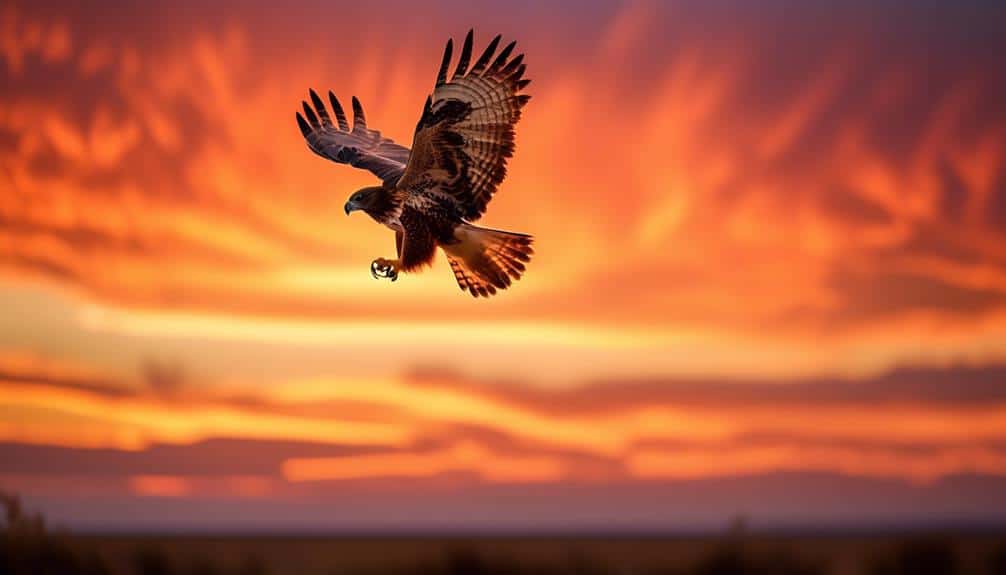
With its impressive wingspan and sharp eyesight, the Red-tailed Hawk is a formidable bird of prey found in Nebraska. This majestic raptor is known for its distinctive red tail feathers, which become more vibrant as the bird matures. The Red-tailed Hawk is a year-round resident in Nebraska, but it also undergoes seasonal migrations. During the summer months, these hawks can be found nesting and breeding in the state's forests and grasslands. However, as winter approaches, many Red-tailed Hawks migrate south in search of warmer climates and ample food sources.
When it comes to hunting, the Red-tailed Hawk utilizes various techniques to secure its prey. One common method is known as soaring and scanning. These hawks will soar high in the sky, using their exceptional eyesight to spot potential prey from above. Once a target is located, the hawk will swiftly dive down, using its powerful talons to snatch its unlucky victim.
Another hunting technique employed by Red-tailed Hawks is called perch hunting. In this method, the hawk will perch on a high vantage point, such as a tree or telephone pole, patiently observing the surrounding area for any signs of movement. When the perfect opportunity arises, the hawk will launch itself towards its prey, employing its speed and agility to strike with deadly precision.
The Eastern Bluebird
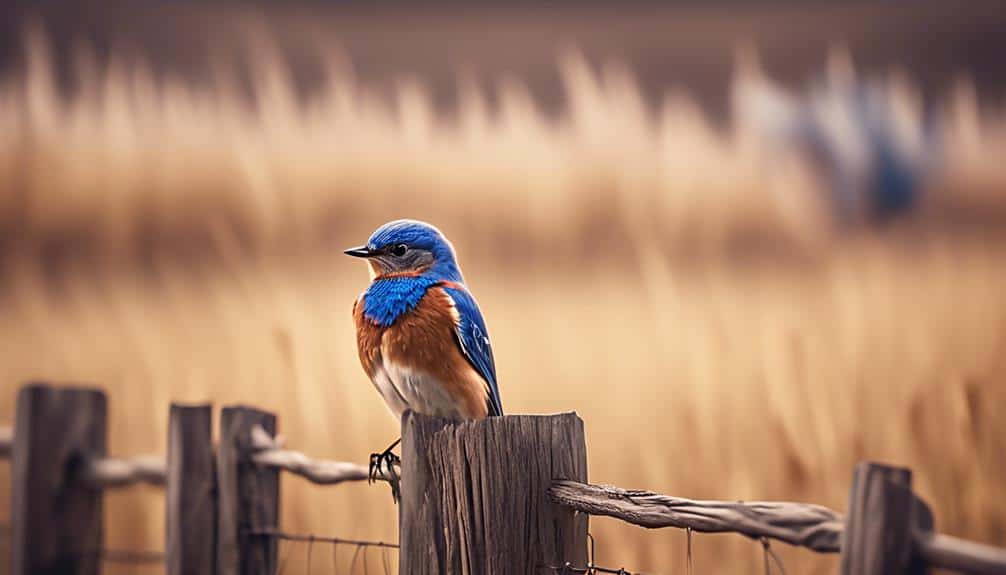
After observing the hunting techniques of the Red-tailed Hawk, it's fascinating to now shift our focus to the Eastern Bluebird, a captivating species found in Nebraska.
The Eastern Bluebird is known for its distinct blue plumage, rusty red breast, and white belly. Here are some interesting facts about this bird:
- Breeding habits: Eastern Bluebirds typically mate for life and are monogamous. They nest in tree cavities or specially designed nest boxes. The female lays a clutch of 3-7 light blue eggs and incubates them for about two weeks. Both parents take turns feeding and caring for the chicks until they fledge.
- Conservation efforts: The Eastern Bluebird has faced habitat loss and competition from non-native species, leading to a decline in their population. However, conservation efforts such as providing nest boxes and creating suitable habitats have helped increase their numbers. Organizations like the Nebraska Bluebird Conservation Initiative work to monitor and protect these birds.
- Diet: Eastern Bluebirds primarily feed on insects, especially during the breeding season. They hunt by perching on low branches or fences and swooping down to catch their prey. They also consume berries and fruits when insects are scarce.
- Song: The Eastern Bluebird has a melodious song consisting of soft warbles and trills. Males often sing to attract mates and establish their territories.
With its beautiful appearance and melodic song, the Eastern Bluebird is a cherished species in Nebraska. Through conservation efforts, we can ensure their continued presence and enjoyment for generations to come.
The Northern Cardinal
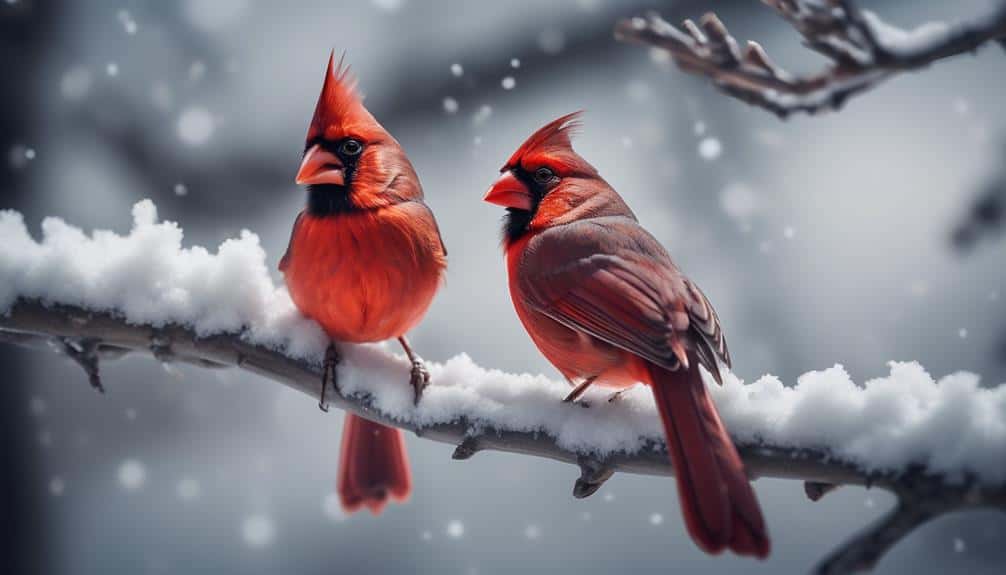
As I turn my attention to the Northern Cardinal, I'm captivated by its vibrant red plumage and melodious song. The breeding habits of Northern Cardinals are fascinating and unique. These birds typically form monogamous pairs and breed once or twice a year. The male cardinal is known for its territorial behavior, defending its nesting territory vigorously. It establishes its territory by singing a loud and distinctive song, which serves to attract a mate as well as ward off potential rivals.
When it comes to breeding, habitat preservation plays a crucial role in the survival of Northern Cardinals. They prefer dense shrubs and thickets for nesting, providing security and protection from predators. Conservation efforts should focus on preserving and creating suitable habitats, such as hedgerows and brushy areas, which offer the necessary cover and food sources for these birds.
Maintaining the integrity of their habitat is essential for the long-term survival of the Northern Cardinal population. The loss of suitable nesting areas due to urbanization and habitat destruction can have detrimental effects on their breeding success. By preserving and restoring their habitats, we can ensure the continued presence of these beautiful birds in our environment.
The Killdeer
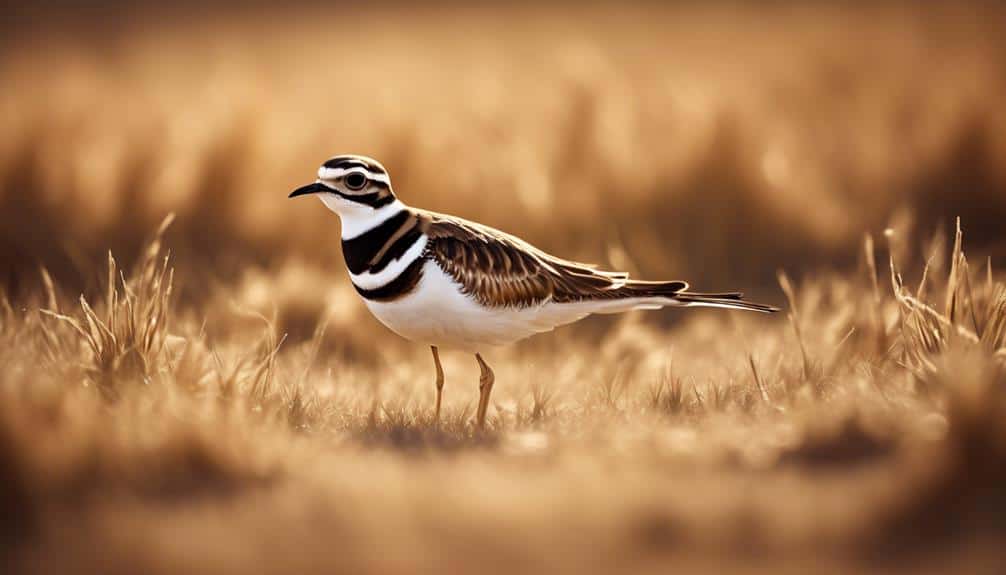
The Killdeer, a species of plover found in Nebraska, is known for its distinctive appearance and behavior. Here are some key aspects of their behavior patterns and nesting habits:
- Distraction Displays: Killdeers are masters of deception. When their nests are threatened, they perform distraction displays to divert attention from their vulnerable eggs. They pretend to be injured, feigning a broken wing, and flutter away, luring potential predators away from their nests.
- Nesting on the Ground: Unlike many other birds, Killdeers construct their nests on the ground. They prefer open habitats such as fields, gravel rooftops, and even golf courses. Their nests are simple scrapes in the soil, lined with pebbles, grass, and other available materials.
- Camouflaged Eggs: Killdeer eggs blend seamlessly with their surroundings. The speckled olive-brown coloration provides excellent camouflage, making them difficult to spot amidst rocks and vegetation. This adaptation increases the chances of survival for their offspring.
- Precocial Chicks: Killdeer chicks are born fully feathered and able to walk and forage shortly after hatching. They leave the nest within hours and start foraging on their own, though they still rely on their parents for protection and guidance.
Understanding the behavior patterns and nesting habits of the Killdeer enhances our appreciation for this remarkable species and the challenges they face in their Nebraska habitats.
The Western Meadowlark
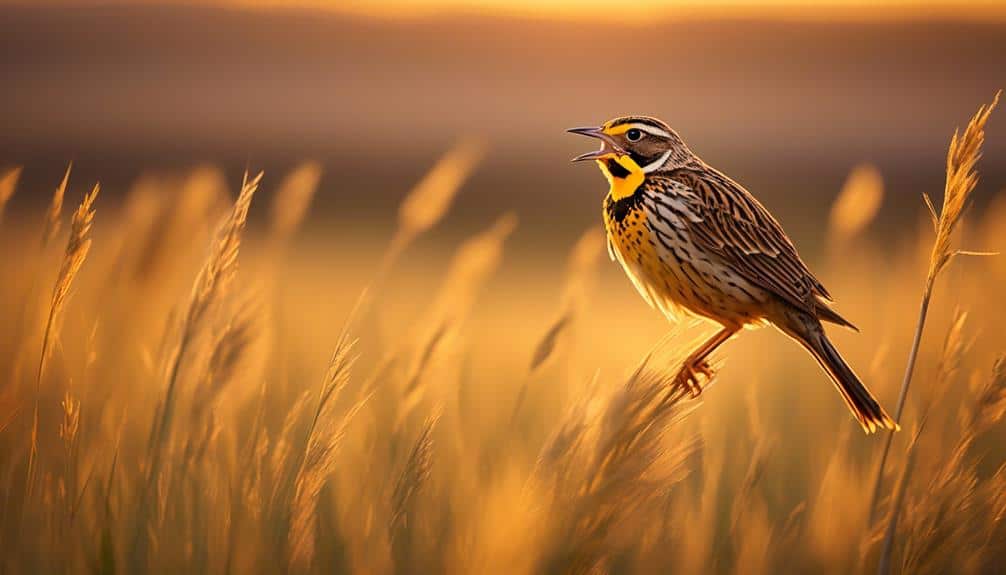
Having explored the fascinating behavior patterns and nesting habits of the Killdeer, we now turn our attention to another remarkable avian species found in Nebraska – the Western Meadowlark.
The Western Meadowlark, scientifically known as Sturnella neglecta, is a medium-sized songbird that belongs to the blackbird family, Icteridae. This species is highly distinctive, with its bright yellow underparts adorned with a black 'V' on the chest and a melodious, flute-like song that echoes across the prairies of Nebraska.
The Western Meadowlark is primarily found in open grasslands and prairies, making it a common sight in Nebraska's agricultural landscapes. It's well-adapted to this habitat, using its long legs and sharp beak to forage for insects, seeds, and berries. This species is known for its habit of perching on fence posts, where it can easily spot prey or potential mates.
The Western Meadowlark plays a vital role in Nebraska's agriculture. As an insectivorous bird, it helps control pest populations, benefiting farmers by reducing the need for chemical pesticides. Additionally, its diet includes weed seeds, which helps limit weed growth in agricultural fields. The presence of Western Meadowlarks is an indicator of a healthy and balanced ecosystem, as they rely on intact grassland habitats for nesting and foraging.
Frequently Asked Questions
How Can I Attract American Goldfinches to My Backyard?
To attract American goldfinches to my backyard, I put up bird feeders stocked with nyjer (thistle) seed. These vibrant yellow birds love the tiny black seeds and will flock to my yard for a tasty meal.
What Is the Wingspan of a Red-Tailed Hawk?
The wingspan of a red-tailed hawk is typically around 4-5 feet. These majestic birds are known for their soaring behavior and can be found in a variety of habitats across North America.
Do Eastern Bluebirds Migrate During the Winter Months?
Yes, eastern bluebirds do migrate during the winter months. They travel to warmer regions in the southern parts of the United States to find food and escape the harsh winter conditions.
What Is the Average Lifespan of a Northern Cardinal?
The average lifespan of a northern cardinal can vary depending on various factors. These factors include habitat, food availability, predation, and disease. Understanding these factors can help us better understand the lifespan of these beautiful birds.
How Do Killdeer Birds Protect Their Nests From Predators?
Killdeer birds have various nesting strategies to protect their nests from predators. They use distraction displays, such as feigning injury, to lead predators away. They also choose nest sites with good camouflage and build shallow depressions to hide their eggs.
Conclusion
In conclusion, the avian residents of Nebraska paint a vibrant and diverse portrait in the tapestry of nature.
Like the American Goldfinch, they bring a splash of sunshine to our lives.
The Red-tailed Hawk soars high, reminding us to reach for our dreams.
The Eastern Bluebird, with its melodious songs, fills our hearts with joy.
The Northern Cardinal's fiery plumage symbolizes the strength and resilience within us.
Lastly, the Killdeer and Western Meadowlark embody the harmony and beauty that nature bestows upon our beloved Nebraska.

